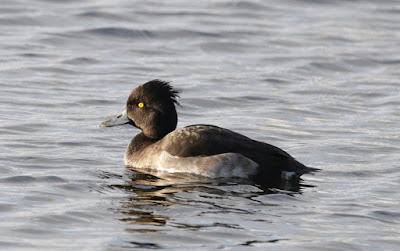I was unavailable for Tuesday’s ringing session when Andy ringed another 35 birds at Oakenclough. He caught the first Siskins and Lesser Redpolls of the autumn and another couple of Tree Pipits but then excelled by catching an adult Spotted Flycatcher, the first full-grown “spot-fly” for a number of years.
Not to be outdone I met up with Andy for another 0630 start on Wednesday. Oakenclough’s recent purple patch continued with 42 more captures of 12 species. There was an exciting morning of birding too, topped off by an adult Hobby about 11 am.
We caught steadily from the off as finches provided the numbers while “others” provided the “star” birds: 14 Goldfinch, 9 Chaffinch, 4 Great Tit, 3 Meadow Pipit, 2 Blackcap, 2 Willow Warbler, 2 Goldcrest, 1 Chiffchaff, 1 Siskin, 1 Lesser Redpoll, 1 Tree Pipit, 1 Blue Tit, 1 Coal Tit.
Both of today’s Blackcaps, a male and a female were birds of the year (juvenile) with the female showing faint fault bars on the tail. Fault bars are pale bands sometimes seen on wing and tail feathers and which are probably due to reduced metabolism with less melanin deposition during the growth of feather, typically during days when food is scarce due to natural causes or poor weather. We have seen few fault bars on young birds’ tails this year, almost certainly a consequence of the best year ever of UK weather as a whole and the best since 2006 in the North West.
Blackcap
Blackcap- juvenile/first year female
Today’s single juvenile Tree Pipit had a tiny mite attached to its face at the bottom of the right eye. We occasionally find such things around the eye and head of a bird but without specialist knowledge we can do little if anything to help. However, it is said that such ticks drop off when the ticks are finished feeding without any long term effect on the bird.
Tree Pipit
Tree Pipit
Meadow Pipit
I hope everyone spotted the difference between Meadow Pipit and Tree Pipit?
Chiffchaffs have been strangely absent this summer and autumn, today’s recently moulted adult the first since 26th March.
Chiffchaff
In recent years we are finding a number of juvenile Goldfinches in full primary moult (replacing all of their primary feathers) in late/summer early autumn. These are juveniles from the earliest broods of April/May and June whose plumage is well worn by late summer. In the picture below the outer feathers are the browner and worn ones; the darker, blacker ones and the short, still emerging feather are the new “adult type” feather. However, the bird is still classed as a first year/juvenile until 1st January 2019 when of course it becomes a second year.
Goldfinch
It’s good to welcome back Siskins and Lesser Redpolls even though we caught just one of each - both adult females.
Lesser Redpoll - adult female
Siskin - adult female
Siskin - adult female
Tail feathers
The birding was pretty spectacular this morning, even with the limited time between rounds. There was an early arrival of 150+ Swallows which arrived so soon after dawn that we thought to be from a local roost. As the morning progressed their numbers increased at the same time as a large influx of House Martins and a handful of Sand Martins. Our estimate of the numbers involved in both visible migration and those lingering while feeding was 375 Swallow, 260 House Martin and 10 Sand Martin.
With so many hirundines about, we speculated about the possibility of a Hobby. About 11 am Bryan cottoned on to a raptor that arrived from the west and shot quickly through where the Swallows and House Martins were feeding. We had less than a minute as the Hobby circled and then flew directly over our heads where we were able to identify it as an adult rather than a bird of the year.
Hobby - Falco subbuteo
Other birds – 8 Grey Wagtail, 6 Pied Wagtail, 7 Buzzard, 2 Sparrowhawk, 2 Great-spotted Woodpecker, 1 Spotted Flycatcher, 1 Nuthatch.













































.jpeg)












.jpg)












